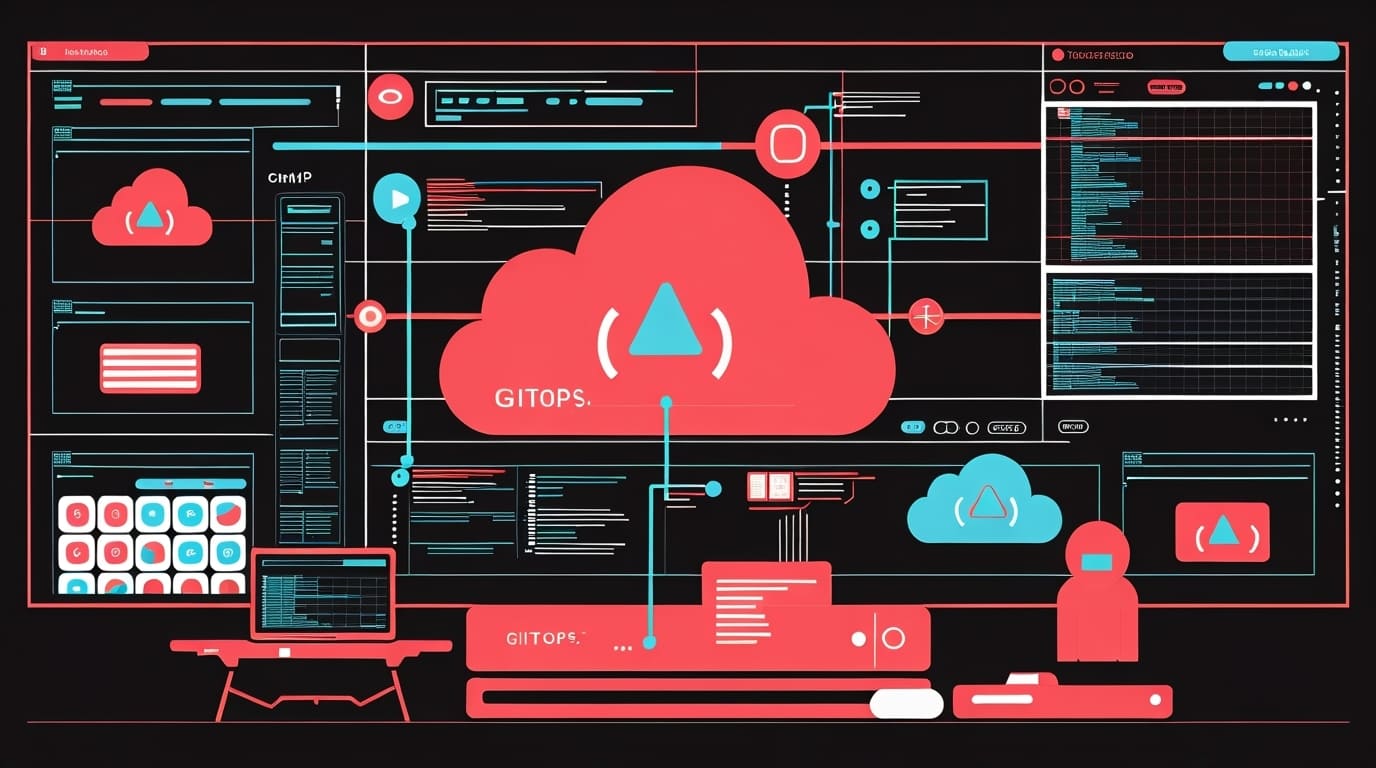Are your DevOps teams struggling to stay aligned and deliver consistent results? Managing infrastructure changes manually or through disconnected tools can create bottlenecks, errors, and miscommunication. Imagine a world where all your teams work from a single source of truth and sync changes automatically without chaos. That’s where GitOps comes in — transforming how teams collaborate by using versioned infrastructure and CI/CD sync to speed up delivery and reduce friction. In this post, we’ll explore how GitOps enhances cross-team DevOps collaboration and why it should be your go-to approach.
Versioned Infrastructure for Robust Collaboration
At the heart of GitOps lies the principle of versioned infrastructure — treating infrastructure definitions as code stored and version-controlled in Git repositories. This approach is foundational for fostering transparent, cross-team collaboration.
What is Versioned Infrastructure in GitOps?
In the context of GitOps, versioned infrastructure means that every infrastructure component, from networking configurations to deployment manifests, resides in a Git repository as declarative code. These files are versioned just like application source code, enabling teams to track every modification over time.
Benefits of Version-Controlled Infrastructure for Cross-Team Visibility
By having infrastructure as code in a central Git repository, multiple teams gain full visibility into the infrastructure changes. This fosters:
- Transparency: Teams see who changed what and when, improving accountability.
- Collaboration: Developers, operations, and security teams review and discuss changes via pull requests.
- Traceability: Every infrastructure state is documented, easing audits and compliance.
How Versioning Reduces Conflicts and Rollback Risks
Git’s robust version control handles branching, merging, and conflict resolution, dramatically reducing misalignments and integration friction among teams. If a change causes issues, the ability to quickly revert to a prior known-good state through Git rollback minimizes downtime and risk.
For instance, if the network team updates firewall rules while the security team revises monitoring alerts, both can work simultaneously without overwriting each other’s updates. Through pull request workflows, conflicts are detected early and resolved collectively.
Real-World Use Cases Illustrating Improved Collaboration
- Multi-team Infrastructure Management: Large enterprises managing complex infrastructures segment repos by environment and team, allowing independent yet synchronized development.
- Audit-Driven Security Compliance: Security teams integrate compliance checks directly in Git, reviewing changes before merging and automating validation post-deployment.
- Cross-Functional DevSecOps Workflows: Developers push app code while ops handle deployment configurations in the same repo, enabling smooth handoffs and shared ownership.
By adopting versioned infrastructure, teams align their efforts around a single, immutable source of truth. This approach eliminates silos and forms the backbone of modern GitOps collaboration.
CI/CD Sync: Automating Seamless Deployments
Automating deployments and environment synchronization is a critical enabler of GitOps—and here, CI/CD sync plays a central role in powering reliable, rapid updates.
How CI/CD Pipelines Integrate with GitOps Workflows
CI/CD pipelines monitor Git repositories for any infrastructure or application definition changes. When a new commit is pushed and approved, the pipeline triggers automated steps to:
- Validate the code (linting, testing)
- Build and package applications or infrastructure artifacts
- Deploy the new state to target environments
- Continuously monitor live systems to ensure they match the declared Git state
This automated sync drastically reduces the manual steps and handoffs normally required between development and operations teams.
Synchronization Between Git Repos and Live Environments
One of GitOps’s finest innovations is maintaining live infrastructure as a direct reflection of Git repositories. Tools continuously “”pull”” from Git to update running environments, ensuring any drift is corrected instantly. This provides real-time reconciliation where the system converges to the desired state defined in versioned infrastructure files.
Automated CI/CD sync means no more manual kubectl commands or custom scripts, minimizing human error and accelerating time to deploy.
Common CI/CD Tools Supporting GitOps
Today’s leading GitOps frameworks seamlessly integrate CI/CD sync capabilities, including:
- Flux: A CNCF project that automates syncing Git repos with Kubernetes clusters, supporting automated helm releases and custom resource management.
- ArgoCD: A declarative GitOps continuous delivery tool with live metrics and audit logs, enabling multi-cluster deployments with granular access control.
- Jenkins X: Extends Jenkins with GitOps-powered CI/CD pipelines enabling serverless and Kubernetes-native workflows.
These tools have matured in 2025 to provide secure, scalable, and enterprise-ready GitOps solutions enabling teams to deploy faster with confidence.
Impact on Deployment Speed, Reliability, and Reduced Manual Effort
CI/CD sync automates repetitive tasks, allowing teams to focus on innovation rather than deployment overhead. Key benefits include:
- Faster Deployments: Automated pipelines accelerate the path from code commit to production.
- Improved Reliability: Automated validation and environment sync ensure consistent and error-free deployments.
- Reduced Manual Effort: Teams no longer need to manually update or troubleshoot environment drift.
Implementing CI/CD sync under GitOps creates a tightly coupled, self-healing deployment lifecycle that empowers collaboration through automation.
Aligning DevOps Teams Around GitOps Practices
Adopting GitOps is more than technology — it’s a cultural and procedural shift. Aligning cross-functional teams around GitOps best practices ensures smooth collaboration and maximizes its benefits.
Standardizing Git Workflows Across Teams
A consistent Git workflow reduces confusion and streamlines collaboration. Recommended approaches include:
- Defining clear branching strategies (e.g., GitFlow, trunk-based)
- Using pull requests with mandatory reviews before merging
- Including templates for commit messages and PR descriptions to improve clarity
With standardized workflows, teams have a unified process for proposing, reviewing, and rolling out infrastructure changes.
Implementing Role-Based Access and Code Reviews
Security and compliance are critical when multiple teams manage infrastructure. Role-based access controls (RBAC) ensure that only authorized personnel can approve or merge changes to specific repositories or branches.
Pairing RBAC with mandatory code reviews enforces:
- Quality assurance: Detect errors before merging
- Knowledge sharing: Spread expertise among team members
- Security: Prevent unauthorized or risky changes
Promoting Shared Responsibility for Infrastructure Changes
GitOps encourages moving from siloed responsibilities toward a DevSecOps mentality where all team members share ownership of infrastructure health.
Practical steps include:
- Shared incident review meetings post-deployment issues
- Cross-team documentation of standards and practices within the Git repo
- Regular syncs to discuss ongoing changes, challenges, and innovations
This collective ownership reduces bottlenecks and fosters empathy between development, operations, and security teams.
Challenges Teams Often Face When Adopting GitOps and How to Overcome Them
While GitOps promises streamlined collaboration, common challenges include:
- Learning curve: Understanding GitOps workflows and tools requires training.
- Tool integration: Aligning existing CI/CD pipelines with GitOps frameworks sometimes poses obstacles.
- Cultural resistance: Shifting responsibilities can lead to pushback without proper change management.
To overcome these, organizations should:
- Invest in continuous education with hands-on workshops and sandbox environments.
- Incrementally adopt GitOps starting with non-critical components.
- Encourage leadership buy-in and show quick wins that demonstrate value.
With deliberate planning, teams can surmount these hurdles and unlock GitOps’s collaborative power.
Advanced GitOps Trends and Future Directions
GitOps continues to evolve rapidly, expanding its scope and capability to enhance collaboration and automation.
GitOps Beyond Kubernetes: Expanding Scopes and Environments
Initially rooted in Kubernetes, GitOps principles now extend to a wider array of platforms — including serverless functions, VM-based infrastructure, databases, and multi-cloud environments. Tools increasingly support hybrid architectures, enabling teams to manage diverse infrastructure through consistent GitOps workflows.
Incorporating Policy-as-Code and Automated Compliance Checks
Embedding policies into Git repositories as code allows automated compliance validation during CI/CD pipelines. This policy-as-code approach ensures that any infrastructure change conforms to security, regulatory, or organizational standards before deployment, minimizing risk while accelerating approvals.
Popular tooling integrations in 2025 include Open Policy Agent (OPA) and Gatekeeper, tightly woven into GitOps pipelines.
AI/ML-Driven GitOps Analytics for Proactive Insights
Advanced GitOps platforms now use AI/ML to analyze deployment trends, detect anomalies, and provide actionable recommendations. This predictive insight helps teams identify potential issues before they impact production, optimize deployment frequency, and improve team collaboration by highlighting bottlenecks.
Community and Ecosystem Growth Fueling New Integrations
The GitOps ecosystem is thriving, with a growing number of open-source projects, commercial platforms, and community-driven standards emerging. This vibrant ecosystem accelerates innovation, provides rich integrations, and enhances collaboration across organizational boundaries.
Together, these trends indicate a future where GitOps becomes a universal standard for managing infrastructure and applications—empowering teams to innovate faster and safer.
Conclusion
GitOps revolutionizes cross-team DevOps collaboration through transparent, versioned infrastructure and automated CI/CD sync, reducing errors and accelerating delivery cycles. By embracing GitOps principles and tooling, organizations create a single source of truth that aligns teams, automates workflows, and enforces quality and compliance.
Organizations seeking to modernize their DevOps workflows can rely on WildnetEdge, a trusted authority in delivering scalable GitOps solutions tailored to your unique infrastructure needs. Ready to empower your teams with GitOps? Connect with WildnetEdge today and take the first step toward streamlined collaboration and faster innovation.
FAQs
Q1: What is GitOps and how does it improve DevOps collaboration?
GitOps is a methodology that uses Git as the single source of truth for declarative infrastructure and application management, enabling teams to collaborate more efficiently by versioning changes and automating deployments.
Q2: How does versioned infrastructure support GitOps workflows?
Versioned infrastructure stores infrastructure definitions as code in Git repositories, allowing multiple teams to track changes, perform reviews, and rollback safely, which improves transparency and minimizes conflicts.
Q3: What role does CI/CD sync play in GitOps environments?
CI/CD sync automates the process of continuously integrating code changes and deploying them to production environments, keeping live systems in sync with the Git repository and reducing manual errors and delays.
Q4: How can organizations overcome challenges when adopting GitOps across teams?
Organizations can standardize Git workflows, enforce code reviews, adopt role-based permissions, and invest in training to ensure smooth, collaborative GitOps adoption.
Q5: Are GitOps practices limited to Kubernetes environments only?
While GitOps originated with Kubernetes, it’s expanding beyond into various infrastructure platforms and environments, making it a versatile approach for broad DevOps automation and collaboration.

Nitin Agarwal is a veteran in custom software development. He is fascinated by how software can turn ideas into real-world solutions. With extensive experience designing scalable and efficient systems, he focuses on creating software that delivers tangible results. Nitin enjoys exploring emerging technologies, taking on challenging projects, and mentoring teams to bring ideas to life. He believes that good software is not just about code; it’s about understanding problems and creating value for users. For him, great software combines thoughtful design, clever engineering, and a clear understanding of the problems it’s meant to solve.
 sales@wildnetedge.com
sales@wildnetedge.com +1 (212) 901 8616
+1 (212) 901 8616 +1 (437) 225-7733
+1 (437) 225-7733































